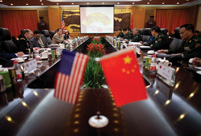 'Jin' named the word of the year by cross-strait netizens
'Jin' named the word of the year by cross-strait netizens Chinese scientific expedition goes to build new Antarctica station
Chinese scientific expedition goes to build new Antarctica station
 Chinese naval escort fleet conducts replenishment in Indian Ocean
Chinese naval escort fleet conducts replenishment in Indian Ocean 17th joint patrol of Mekong River to start
17th joint patrol of Mekong River to start China's moon rover, lander photograph each other
China's moon rover, lander photograph each other Teaming up against polluters
Teaming up against polluters
Source of the Culture of the Three Kingdoms Period
In the Three Kingdoms Period between the end of Han Dynasty and Wei and Jin Dynasties when a group of independent warlords fought with each other in times of crisis, Xiangyang could be said to be the talent highland, culture highland, and spirit highland. Symbolized by Liu Bei's three visits to the cottage in succession and Zhuge Liang's drawing up the Longzhong Plan, Xiangyang became the source of the tripartite confrontation pattern. Symbolized by the fact that Yang Hu guarded Xiangyang and Du Yu proposed a general plan for conquering the state of Wu, Xiangyang became the source where the Jin Dynasty conquered Wu and completed the great cause of reunification. In the late Eastern Han Dynasty, northern China suffered from the chaos caused by war. Liu Biao held the post of magistrate in Jingzhou (190 AD to 209 AD). He cared for common people and cultivated talents for easy self-protection. Under his governance, Xiangyang enjoyed economic prosperity and social stability and became a peaceful "Oasis" in the turbulent days. Thousands of talents rushed to Xiangyang in succession. A number of excellent talents gathered in Xiangyang, including: strategic elites such as Zhuge Liang, Sima Hui, Pang Degong, Pang Tong, Xu Shu, and Cui Zhouping; Confucian scholar Song Zhong; litterateur Wang Can; calligrapher Liang Gu; musician Du Kui. At that time, Xiangyang gathered numerous talents and became so flourishing to be the academic center of the country. Besides, taking the lead in such respects as education, culture, and academic studies, Xiangyang became a region where a splendid cultural phenomenon demonstrated itself to the full. Learning from the Imperial College in Luoyang, Xiangyang established the only official school. Moreover, Xiangyang took the lead in determining the Five Classics Chapters and Sentences as the learning material for Confucian classics studies. The books collected by the feudal government were the most in the country. Such academic prosperity continued till the Eastern Jin Dynasty. Historian of Eastern Jin Dynasty Xi Zaochi wrote the Ages of Han and Jin Dynasties and the Old Records of Xiangyang, leading to a profound influence on the development of history as a study in China. The eminent monk of Eastern Jin Dynasty, Shi Daoan, stayed in Xiangyang for 15 years to study Buddhism and give lessons on sermons and doctrines. He unified the Buddhism and named it as Shi. By establishing the rules for monks, he was the first that created Chinese Buddhism system. He wrote the first catalogue of Buddhist texts in China and set up the foundation for sinicization of Indian Buddhism. Because of his great contribution to the pattern of Chinese cultures (Confucianism Buddhism Taoism) and the development of the whole Chinese Buddhism, Xiangyang once became the transmission center of national Buddhism. Being the "hometown of Chinese Culture of Three Kingdoms", Xiangyang has abundant heritages of Culture of Three Kingdoms. 18 volumes of the 86-volume Annals of Three Kingdoms mentioned Xiangyang, and stories mentioned in 32 chapters of the 120-chapter The Romance of The Three Kingdoms took place in Xiangyang. Now, there are more than 50 historical and cultural sites from the Three Kingdoms Period. Stories of the Three Kingdoms Period are popular among families in Xiangyang, including: Sima Recommended Talents, Liu Bei Visited Cottage Thrice in Succession, Horse Jumped through Tan Brook, Guan Yu Flooded Seven Armies, and Hua Tuo Cured Guan Yu by Scraping Bone and Removing Poison


 Commemorate 120th birth anniversary of Mao Zedong
Commemorate 120th birth anniversary of Mao Zedong Female soldiers of PLA Marine Corps in training
Female soldiers of PLA Marine Corps in training Chinese cities to have a very grey Christmas as smog persists
Chinese cities to have a very grey Christmas as smog persists China and U.S. - the national image in each other’s eyes
China and U.S. - the national image in each other’s eyes The Liaoning's combat capability tested in sea trial
The Liaoning's combat capability tested in sea trial Chinese pole dancing team show their moves in snow
Chinese pole dancing team show their moves in snow Rime scenery in Mount Huangshan
Rime scenery in Mount Huangshan Ronnie O'Sullivan: My children mean the world to me
Ronnie O'Sullivan: My children mean the world to me Shopping in Hong Kong: a different picture
Shopping in Hong Kong: a different picture SWAT conducts anti-terror raid drill
SWAT conducts anti-terror raid drill AK-47 inventor dies at 94
AK-47 inventor dies at 94 Mother practices Taiji with her son
Mother practices Taiji with her son  Crashed French helicopter salvaged
Crashed French helicopter salvaged Winter travels in Anhui
Winter travels in Anhui  Bird show opens to public in Calcutta, India
Bird show opens to public in Calcutta, IndiaDay|Week|Month